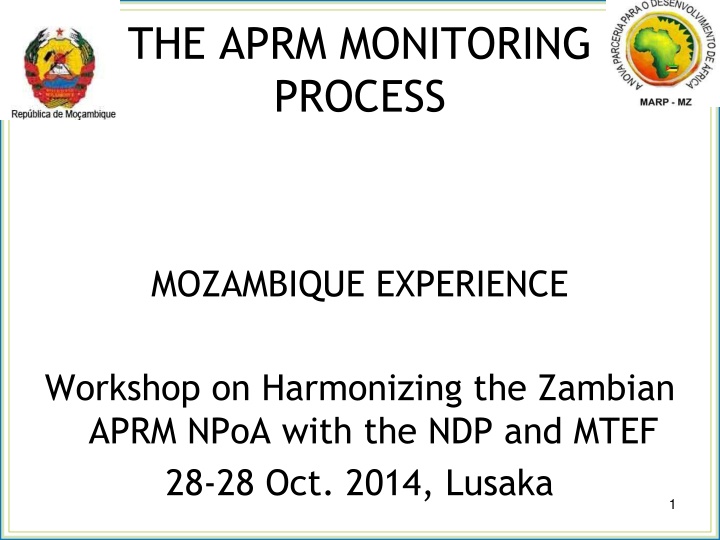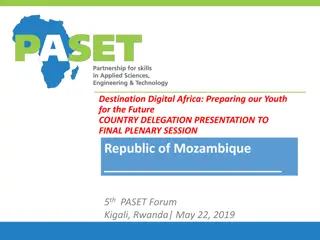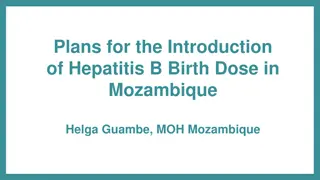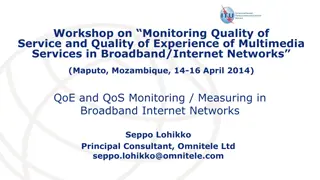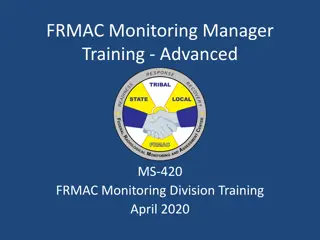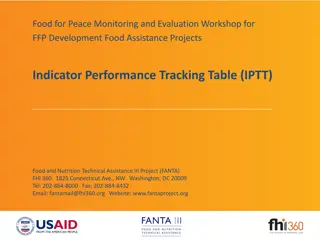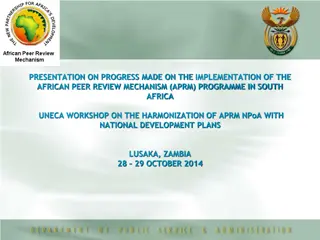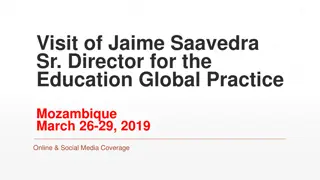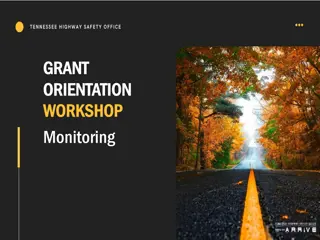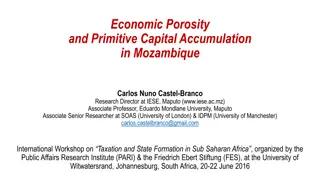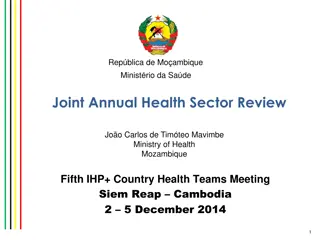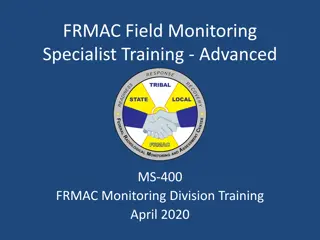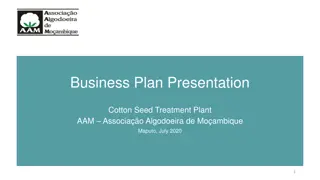Monitoring Process in Mozambique: Lessons from APRM Workshop
Understanding the APRM monitoring process in Mozambique through workshops on harmonizing strategies, objectives, and outcomes. Explore the background, objectives, scope, and value of the monitoring and evaluation system in the country.
Download Presentation

Please find below an Image/Link to download the presentation.
The content on the website is provided AS IS for your information and personal use only. It may not be sold, licensed, or shared on other websites without obtaining consent from the author.If you encounter any issues during the download, it is possible that the publisher has removed the file from their server.
You are allowed to download the files provided on this website for personal or commercial use, subject to the condition that they are used lawfully. All files are the property of their respective owners.
The content on the website is provided AS IS for your information and personal use only. It may not be sold, licensed, or shared on other websites without obtaining consent from the author.
E N D
Presentation Transcript
THE APRM MONITORING PROCESS MOZAMBIQUE EXPERIENCE Workshop on Harmonizing the Zambian APRM NPoA with the NDP and MTEF 28-28 Oct. 2014, Lusaka 1
CONTENT BACKGROUND OBJECTIVES OF THE M&E SCOPE OF THE APRM M&E WHAT TO MONITOR, AND HOW? PLANNING THE M&E METHODS FOR DATA COLLECTION THE IMPLEMENTATION PROCESS AND THE PROGRESS REPORT REPORTING PROGRESSES VALUE OF LEARNING PROCESS 2
BACKGROUND Mozambique join the APRM family in 2003; in 2005 the cabinet appointed the ministry of planning and development as APRM focal point; In 2006 a NGC was set up composed by 58 individuals representing the Mozambican society such as parliament, government, trade unions, human rights, farmers, youths and women's organizations, disable people associations, academia, private sector and religious representatives; The country has already achieved the five stages of his first peer review process, which culminated with the submission of his draft review report to the 11th APRM head of states summit in June 2009 in Libya; However, only in May 2011 the final country review report was launched officially, after a full incorporation of the comments of government and his peers; The dissemination of the report report and the begin the implementation of the program of action starts in 2011; In January 2014 during the 20th APRM summit Mozambique presented his first progress report on the implementation of the APRM national programme of action. 3
OBJECTIVES OF THE M&E SYSTEM Build greater transparency and accountability from the state authorities and public servants in regard to implementation of the APRM Action Plan and the recommendations from the Panel of Eminent Persons and provide to the policy-makers a clearer basis for decision-making in order to improve the quality of outcomes. 4
SCOPE OF THE APRM M&E The current APRM M&E system covers the four thematic areas of the APRM: Democracy and political governance Economic Governance and Management Corporate governance Socio-economic development The scope of intervention in implementing the system includes the central and local levels, as well as covers the areas of municipal governments. Each thematic areas is comprised by at least 6 to 8 member of the National Governing council. One of them is the team leader. 5
WHAT TO MONITOR, AND HOW? Mozambique most recent APRM Progress Report cover the period 2010- 2012 and was produced in April 2013. The M&E process track the government commitments on APRM take in account that the government is the main implementing agency of the APRM action plan activities. Structures to support the implementation of APRM including the monitoring process was established, namely: NGC divided into 4 working thematic groups according to ARM thematic areas APRM focal points in all ministries , provincial governments and focal points from CSOs in all provinces. APRM secretariat overseen by the Minister of Planning and Development to coordinate de M&E process. The entry point in each government units/ministries is the local focal point. Is responsible to track the progress of activities associated to APRM action plan at his ministry and report to National Secretariat upon request to be presented to NGC thematic areas working groups. 6
PLANNING THE M&E Who should be involved and when? Identifying who will collect information on indicators, when and who will receive it Who will be involved in reviewing progress and providing feedback and how it will occur What resources are needed and available? The human and financial cost of gathering, reporting and reviewing data Needed funding, time and people 7
METHODS FOR DATA COLLECTION Interviews, routine reporting, sentinel sites (the last needs to be strengthened) Piggyback on existing data collection systems (e.g. government existing systems) Both formal/informal and quantitative/qualitative methods Analysis of studies, evaluations and international reports (HDI; Mo Ibrahim Index; WB Governance Index; etc.) Quarterly data collection by the National APRM Secretariat Challenges faced on data collections How to record systematically the data and report clearly Set-up a comprehensive time and skills of those who will collect the data Training of APRM National Secretariat staff, NGC, Focal points on the M&E tool Consolidate mechanisms for liaison with government institutions and improve the system of information flow 8
THE IMPLEMENTATION PROCESS AND THE PROGRESS REPORT The National Secretariat and the NGC are the bodies that makes the ongoing activities within the framework of APRM, and ensure coordination with the Focal Points and other stakeholders such as Civil Society and Private Sector. According to the schedule of the planning cycle of the government, the ministries receive a letter requesting information on progress of activities associated to APRM. Members of the NGC working groups and team of consultants hired subsequently analyze the information and crosschecking with other sources to validate and produce a draft report for each thematic areas. A public presentation of the draft of the progress report is held as well as a presentation to cabinet is made by the chairman of the NGC. After including all comment the NGC send the progress report to the Head of State to be presented at the APRM summit of the Head of States and Governments. 9
REPORTING PROGRESSES Logical Framework on the M&E Goal Strategic Objectives Intermediate Results Outputs Activities 10
VALUE OF LEARNING PROCESS Consultation and Training Identify strengths and weaknesses on potential users of the M&E Discuss the monitoring program with stakeholders from each level before it is put into effect Provide training to those who will be using the M&E systems Prepare a work-plan For each year Listing the main activities to be carried out, their output, timing and parties involved Lessons to learn What needs to be deepened and why? What can be drawn as a best practice and why? What conditioned the good results, and failures what were the main reasons? 11
THANK YOU FOR YOUR ATTENTION! 12
